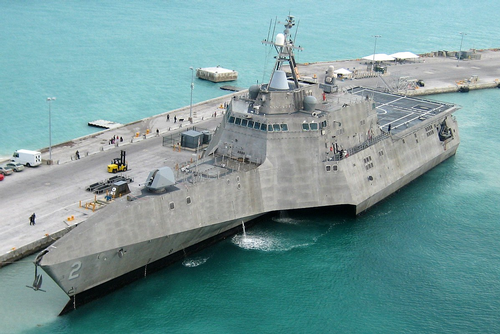WEDNESDAY, MAY 27, 2020
According to reports, the United States Navy has begun exploring the use of a new digital software to help combat shipboard repairs and maintenance services.
Called a “digital twin,” the technology is reportedly comprised of IT networks where maintenance engineers located at surface warfare centers can identify damage, corrosion and alignment issues more quickly. The practice aids crews in being more proactive about the vessel’s maintenance prior to docking at the port.
“Our ability as in-service engineers to support the fleet currently requires extensive onsite personnel in order to identify configuration, damage, corrosion and other mechanical issues,” Alan Jaeger, manager of Naval Sea Systems Command’s Office of Research and Technology Applications, said in a statement.
“The concept of a ‘digital twin’ or as-built models of surface ships provides extensive opportunities to better serve the fleet. Imagine being able to not only collect valuable information without placing maintenance personnel in potentially hazardous situations, but to also do it with the ship underway while obtaining better and more accurate data in the process."
Digital Twins
Back in June 2018, Naval Surface Warfare Center in Port Hueneme, California, signed a Cooperative Research and Development Agreement with unmanned aerial systems company, Aerial Alchemy.

 |
|
U.S. Navy photo by Naval Air Crewman 2nd Class Nicholas Kontodiakos, public domain, via Wikimedia Commons |
|
According to reports, the United States Navy has begun exploring the use of a new digital software to help combat shipboard repairs and maintenance services. |
Through the agreement, the team has been researching how digital twins can be used and began by producing a digital twin of the research vessel “Independence” in addition to other ships in the U.S.S. Theodore Roosevelt strike group.
Prior to the agreement, the Navy was still commonly using the Consolidated Afloat Networks and Enterprise Services program, which aims to move all its ships toward a common IT baseline. However, because every ship is different, the move to a digital twin approach has developers exploring more accurate models of vessels in a real-world network at any particular point in time.
To create a digital twin, Aerial Alchemy first worked to define the appropriate amount of remote-sensing technologies that would be needed to design a purpose-built unmanned aerial system. According to reports, Aerial used LiDAR and hyperspectral imaging, which is able to analyze information collected from across an electromagnetic spectrum.
The technology can also detect corrosion, as paint reflects radiation differently if there is underlying rust.
Scans from drones and onboard photogrammetry were used as well, to create a time-based, geotagged, metadata-dense models of the Independence. The Federal Laboratory Consortium for Technology Transfer reports that these models are much more actionable datasets which can lead to a reduction in maintenance costs and human error because engineers are now able to make decisions prior to failure by degradation.
Once collected, the information is collected for operation in a commercial cloud environment where maintenance engineers (both on and offshore) can develop solutions.
“We can catch all the problems before they ever hit a piece of hardware,” said Robert Parker, Technical Director in the Navy’s Program Executive Office for command, control, communications, computers, and intelligence.
“We’re trying to push testing and development as far to the left as possible. We want to build a model from day one that encapsulates all the interfaces, all the data exchanges, all the messages. So before you write a single line of code, you can check to see if you have the applications laid out correctly.”
The project is part NSWC’s Naval Innovative Science and Engineering research on technologies that can advance the future of in-service engineering. The Federal Technology Transfer Act of 1986 allows warfare centers and research laboratories to collaborate with industry and academic in research, engineering and technology development.
Other Recent Ship Maintenance Technology
Last month, Norwegian paints and coatings manufacturer Jotun (Sandefjord, Norway) announced the launch of Hull Skating Solutions, a proactive cleaning solution for the maritime industry.
According to the company, the HSS offers high performance antifouling, proactive condition monitoring, inspection and proactive cleaning, high end technical service, and performance and service level guarantees.
Prior to the announcement, in September 2019, a team of engineers at the Corrosion and Coatings Engineering Branch at the U.S. Naval Surface Warfare Center, Carderock Division (Potomac, Maryland) reported that they had developed a new standardized method of conducting ship inspections, which is believed to lower current maintenance costs.
Through a new set of maintenance-requirement cards, inspection methods and repairs are explained through step-by-step instructions. One of the developed MRCs recommends annual inspections of exterior steel window-frame structures for corrosion, sealant shrinkage and cracks. Should ship corrosion show more than 10% of a linear area around windows, or if there are issues with the sealant, the second MRC explains proper repair and preservation steps to be taken for the exterior window structure and sealant replacements.
Tagged categories: Coatings Technology; Corrosion protection; Inspection; Inspection equipment; Maintenance programs; Marine; Quality control; Quality Control; Rehabilitation/Repair; Ships and vessels; Technology; U.S. Navy